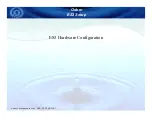
L-4425
MAFH-A
User Manual
4
En
HYDAC
1. INTRODUCTION
HYDAC’s patent pending dewatering unit (MAFH-A) is the first of its kind on the market. The MAFH-A offers
fully automated dewatering of hydraulic fluids and a variety of other petroleum based fluids.
The operating principle of the MAFH-A differs from existing dewatering methods. The MAFH-A is a positive pressure system
that uses 100% mass transfer to remove water from the operating fluid. Room air is heated using a proprietary method to
improve the ability of the air to absorb water vapor. This heated air is then distributed upwards in the reaction chamber
through cascading droplets of operating fluid. The heated air stream removes free, emulsified, & dissolved water and some
dissolved gases.
In most traditional industrial vacuum dehydrators, mass transfer is also the means to dewater. A mild/medium vacuum
expands the room air and proportionately reduces the relative humidity of the air. The air flow is limited to the displacement
of the vacuum pump. Higher efficiency vacuum units use a closed cycle to seal operating fluid with high heat and high
vacuum to boil off water. These units have high efficiency but have low flow rates and can potentially damage the operating
fluid over time.
Since the air flow rate of the HYDAC’s MAFH-A is not limited by vacuum pump displacement, it is more effective in
dewatering operating fluids under similar conditions and flow rates than the above technologies. In addition, the MAFH-A
does not have the initial and maintenance economic disadvantages of a vacuum pump based system.
The MAFH-A uses a regenerative air injection system to heat and distribute room air into the reaction chamber. The optional
compressed air system uses an available dried, clean air source. Any residual fluid mist is mechanically separated from the
moist air stream before it is vented from the chamber. The system fluid is cycled through the reaction chamber via a system
including a vane pump, two valves, and three filters. During the first cycle, fluid is pumped and gently sprayed on top of
the loose, reticulated media until the fluid level in the sump triggers the high float switch. The fluid is then pumped from the
pump and returned to the customer’s reservoir.
The MAFH-A is controlled by a control system which monitors system function and controls the cycle operation.
An on-board water sensor (AS1000) monitors the relative humidity of the operating fluid and displays the actual humidity
value at the control panel.
Summary of Contents for MAFH-A
Page 1: ...L 4425 MAFH A Operating Maintenance and Troubleshooting Manual ...
Page 2: ...L 4425 Created 8 2015 Rev 4 2017 ...
Page 13: ...User Manual MAFH A L 4425 HYDAC En 13 Appendix 2A Hydraulic Schematic Series D ...
Page 14: ...L 4425 MAFH A User Manual 14 En HYDAC Appendix 3A Electrical Schematic Series D ...
Page 17: ...User Manual MAFH A L 4425 HYDAC En 17 Appendix 6A Electrical Schematic G3066 Unit ...
Page 18: ...L 4425 MAFH A User Manual 18 En HYDAC ...
Page 19: ...User Manual MAFH A L 4425 HYDAC En 19 ...





































